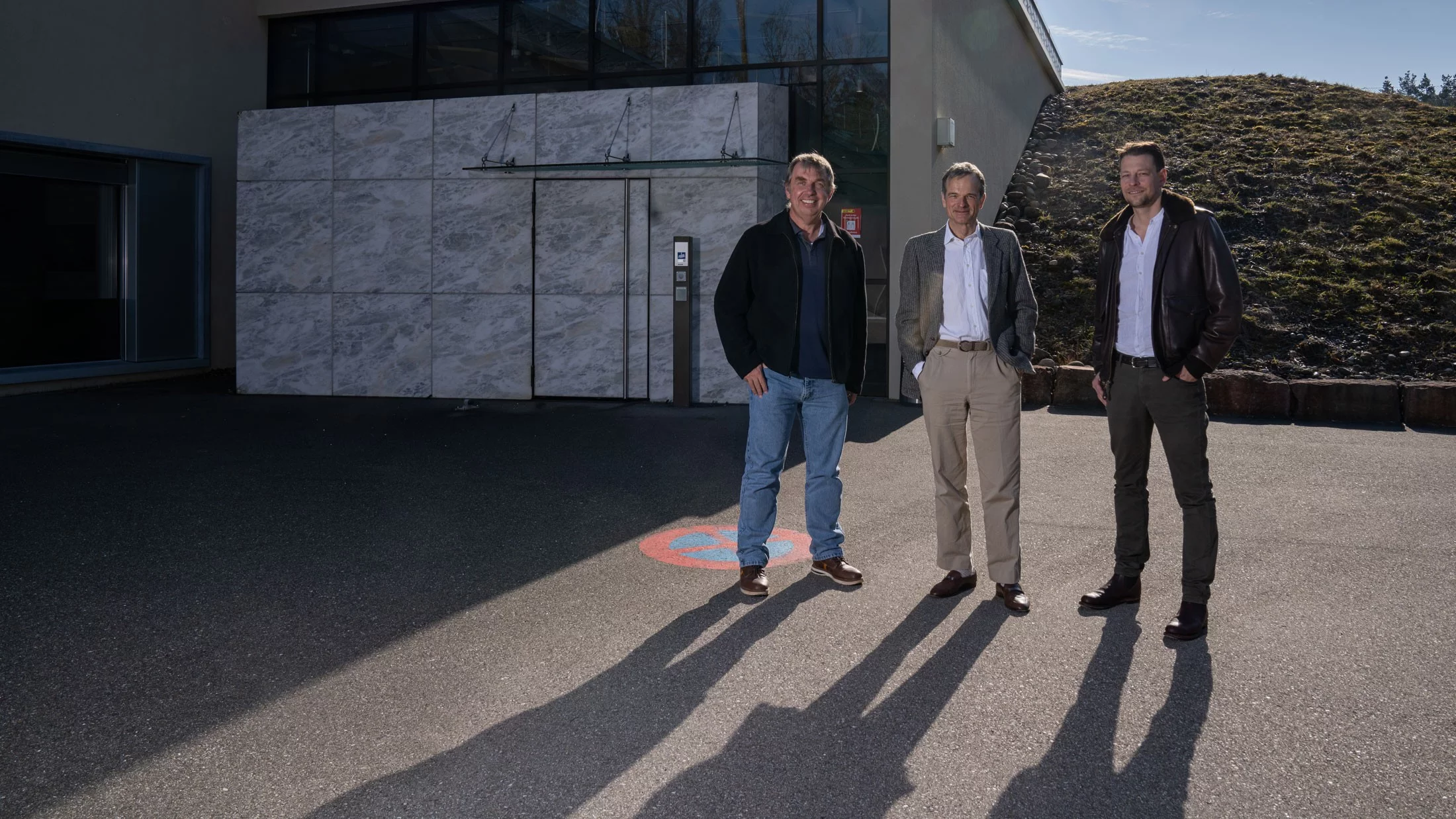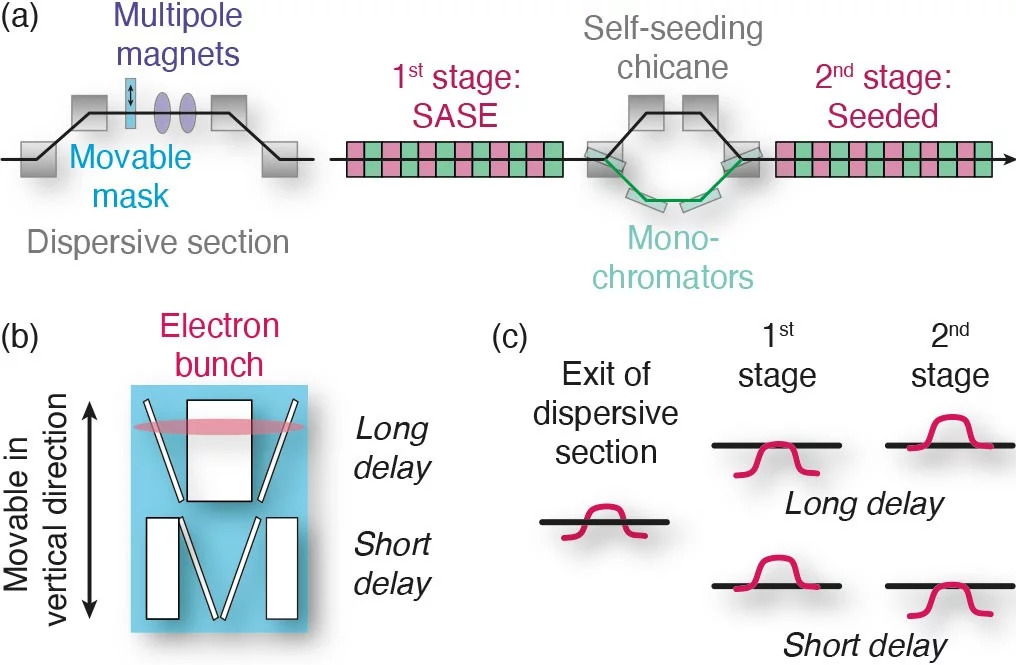The possibility to generate coherent copies of X-ray pulses from FELs would facilitate a realm of X-ray techniques analogous to those currently available with optical laser light. Yet, this is a challenge due to the short wavelength of X-rays. Now, researchers have devised a new solution that ‘splits’ the electron bunch prior to generation of photons, producing two perfectly coherent copies of pulses.
X-ray free electron lasers (FELs) deliver ultra-bright, ultra-short and coherent X-ray pulses. Short pulses enable time-resolved studies of phenomena such as optical switching, whilst the short wavelength of X-rays, enables experiments with clear fingerprints of atomic species, which also resolve the distances between atoms in solids and liquids. In contrast, optical spectroscopies and microscopies primarily probe electrons shared across molecules, and provide neither images at the atomic scale nor allow unique identification of atomic constituents. Thus, X-ray FELs provide essential insights for fields ranging from pharmacology to electronic device engineering.
Yet, so far, part of the picture that is missing is the ability to do experiments with two – or more – coherent copies of beams. Splitting light is par for the course in optical spectroscopies. Phase-locked pulses – pulse pairs that have a fixed phase relation, split via mirrors, enable a host of interferometric and multidimensional spectroscopies. For X-ray light, the challenge comes with the advantage: the short wavelength. The wavelength – of the order of interatomic spacings – makes it extremely challenging to split the beam using mirrors, where even the smallest path length difference introduces phase jitter.
A perfect X-ray beam splitter
Now, researchers at the SwissFEL have come up with an ingenious solution. This takes a step back in the FEL and ‘splits’ the electron bunch in the accelerator, prior to the production of photons. Collaborators from both the electron and photon ends of SwissFEL have been a feature of this project, which uses a solution from the accelerator side to meet the photon requirements.
“What is really special is that from the beginning this has been a close interaction between quantum technologists and accelerator physicists. This is really facilitated by the interdisciplinarity of PSI, and its early recognition that the current, second quantum revolution will impact its core activity of building and operating large machines”, believes Simon Gerber, head of the Quantum Photon Science Group and corresponding author in the recent publication.
In their publication in the journal PNAS, the researchers describe a FEL operation mode, simulated for the Athos soft X-ray beamline at SwissFEL, which will enable the production of phase-locked ultrafast X-ray (PHLUX) pulses with delays of up to 100 fs between them. By ‘splitting’ the electron bunch in the accelerator, the researchers achieve what they describe as a ‘perfect’ beam splitter.
“Because of the way we prepare the beam, both parts pass through exactly the same trajectory and so will always feel the same disturbance – they don’t change relative to one another,” explains Sven Reiche, head of the FEL Beam Dynamics Group and first author of the publication.
The team proposes modifications at the undulator stage of the FEL, which result in an electron bunch that lases in two well-defined longitudinal slices. These modifications include the use of a microfabricated mask – or ‘slotted foil’ - to split the electron beam, followed by separation through transverse tilting of the electron beam and finally self-seeded photon emission. Self-seeding is a concept, whereby photons produced in the first part of the undulators by self-amplified spontaneous emission (SASE) act as the ‘seed’, to trigger the electrons in a later stage of the undulator to lase. The addition of a self-seeding chicane between undulators ensures a high degree of coherence even for pulses with a large temporal separation.
The proposed PSI solution has key advantages over others in terms of its stability and applicability to any X-ray energy, soft or hard.
Applications from time-domain interferometry to quantum optics with free-electron lasers
The ability to generate phase-locked ultrafast X-ray pulse pairs from FELs would open the doors to a world of X-ray optics and spectroscopy, analogous to the current offerings using laser light in the infrared, visible and near-UV.
One application highlighted by the team is time-domain interferometry. This would be the X-ray analogue of Fourier transform infrared (FTIR) spectroscopy – a highly popular and extremely efficient spectroscopic probe for applications across all of science, medicine and engineering. The ability to perform these experiments in the X-ray regime would marry the advantages of FTIR with the advantages of FEL light in terms of time resolution and site specificity.
The team envisage further applications in the field of X-ray quantum optics. A dream experiment would be to use the phase control of the X-ray pulses to mimic the phenomenon of self-induced transparency, whereby the absorption of ultrashort and ultra-bright light becomes extremely small. This could enable scattering experiments to be performed with low absorption, thus minimising damage – a potentially game-changing prospect.
“By having such control over your pulses you could even start reducing radiation damage which until now has always been the Achilles heel of X-ray measurements.” declares Gabriel Aeppli, head of the Photon Science Division and corresponding author of the publication.
Text: Paul Scherrer Institute / Miriam Arrell
Contact
Dr. Simon Gerber
Head of Quantum Photon Science Group
Paul Scherrer Institute
Forschungsstrasse 111
5232 Villigen PSI
Switzerland
Telephone:+41 56 310 39 65
Email:simon.gerber@psi.ch
Dr. Sven Reiche
Head of FEL Beam Dynamics Group
Paul Scherrer Institute
Forschungsstrasse 111
5232 Villigen PSI
Switzerland
Telephone: +41 56 310 51 19
Email: sven.reiche@psi.ch
Prof. Dr. Gabriel Aeppli
Head of Photon Science Division (PSD)
Paul Scherrer Institute
Forschungsstrasse 111
5232 Villigen PSI
Switzerland
Telephone: +41 56 310 42 32
Email: gabriel.aeppli@psi.ch
Original Publication
A perfect X-ray beam splitter and its applications to time-domain interferometry and quantum optics exploiting free-electron lasers
S. Reiche, G. Knopp, B. Pedrini, E. Prat, G. Aeppli, and S. Gerber
Proceedings of the National Academy of Sciences of the United States of America 2022
DOI: 10.1073/pnas.2117906119
Further Information
SwissFEL | SwissFEL | Paul Scherrer Institut (PSI)
Quantum Photon Science | LXN | Paul Scherrer Institut (PSI)
Copyright
PSI provides image and/or video material free of charge for media coverage of the content of the above text. Use of this material for other purposes is not permitted. This also includes the transfer of the image and video material into databases as well as sale by third parties.


